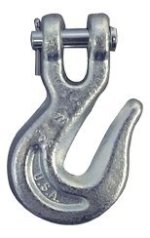Gary Fowler
Super Star Member
- Joined
- Jun 23, 2008
- Messages
- 11,998
- Location
- Bismarck Arkansas
- Tractor
- 2009 Kubota RTV 900, 2009 Kubota B26 TLB & 2010 model LS P7010
x2 ,I have to agree for sure. There is just no way a tractor FEL can put enough lifting pressure to break a hook if properly used. THAT means hooking the chain into the throat of the hook and not on the point. Even if hooked on the point I would not think a tractor of less than 100 HP could break a chain hook lifting with the FEL, BUT always put your chain in the throat just to be safe and proper.Grade 100 is just plain overkill for a tractor. A G70 3/8" hook is rated for 6,600 pounds, and a 5/16" 4,700 pounds. The bucket would fall off the tractor before one of those broke!
http://www.boltonhooks.com/images/Chain WLL1.jpg
All of the cast weld on hooks are that AWD, Grainger, KBOGH, and various other places sell are made in China and distributed by BA Products.
I put on some hooks like the ones made for installing on the end of a chain in 3/8" Gr 70 hook size. I cut off the bottom of the U that hooks into the chain and beveled both sides for a almost full penetration weld. I first welded on a 4 x6 x 1/4" reinforcement plate to the bucket then the hooks to the reinforcement pad. No way are you going to break off those hooks if properly installed and welded. I think (NOT SURE) I got mine at Harbor Freight and for sure they are Chinese made forged steel hooks as almost everything is today. I know my Gr. 70 chains are and they hold good. I pulled the belly attachment for my 70 HP tractors drawbar off and didn't damage the 3/8" chain from HF so I know it will hold anything that I hook on with my loader which is only rated at 3500 lb lift capacity although it may lift a bit more.
